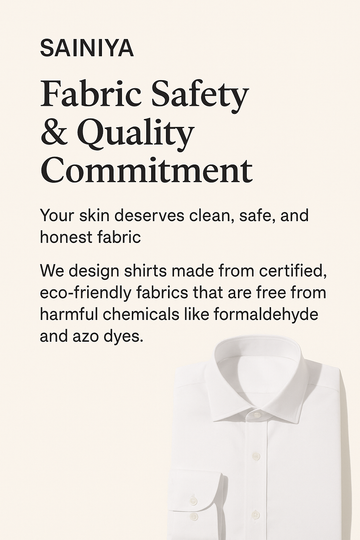Q1: What Are Most Clothing Fabrics Made Of?
Most clothing fabrics are made from a blend of natural fibers (like cotton, linen, silk, or wool) and synthetic fibers (like polyester, nylon, or spandex).
To make fabrics softer, stronger, or wrinkle-resistant, textile mills often use chemical finishing processes such as:
Dyeing and bleaching
Anti-wrinkle or resin finishing
Color fixing or antimicrobial treatments
Softening and shrink-resistant coatings
While these treatments improve fabric performance, they can sometimes introduce harmful residues if not managed carefully.
Q2: Which Chemicals in Textile Production Can Be Harmful to Skin or Health?
Two common groups of harmful substances found in fabric finishing include formaldehyde and azo dyes (aromatic amines).
| Substance | Health Risk | Common Use | Reference |
|---|---|---|---|
| Formaldehyde | Can cause skin irritation, allergies, and respiratory issues; long-term exposure may increase cancer risk. | Used in anti-wrinkle resins and textile finishing. | NIH: Exposures in the Textile Industry / ScienceDirect: Contact Dermatitis from Formaldehyde |
| Azo Dyes (Aromatic Amines) | Some may release carcinogenic aromatic amines or trigger skin allergies. | Used in synthetic dyeing, especially deep colors. | Allergy Standards Ltd. / TextileFocus Overview |
Other potential concerns include heavy metals (used as dye fixers) and volatile organic compounds (VOCs) released during coating or finishing. (Lydia Dupree Journal)
These chemicals can remain in clothing and release over time, especially with heat, sweat, or friction — potentially irritating sensitive skin.
Q3: Why Are These Issues Critical for Global DTC Fashion Brands?
For cross-border DTC brands, safety and compliance are essential.
Different regions have strict textile chemical regulations, such as REACH (EU), OEKO-TEX, and GOTS.
If a product fails testing in Europe or the U.S., it can be:
-
Rejected or fined at customs
-
Recalled from stores
-
Damaging to brand trust
Today’s conscious consumers care not just about how clothes look — but how they’re made.
Q4: How Does Sainiya.shop Ensure Safety and Transparency?
At Sainiya.shop, we believe beauty and responsibility must go hand in hand.
We follow a rigorous sourcing and testing process to ensure every fabric is skin-safe, certified, and eco-conscious.
| Step | Sainiya’s Approach | Why It Matters |
|---|---|---|
| Supplier Verification | Partner only with OEKO-TEX®, GOTS, or ZDHC certified textile suppliers. | Ensures no harmful chemical residues. |
| Eco Dyeing & Finishing | Use low-impact dyes, formaldehyde-free resins, and non-azo pigments. | Safer for both workers and wearers. |
| Multi-Stage Washing | Rinse and neutralize fabrics to remove any chemical traces. | Reduces irritation and odor. |
| Third-Party Testing | Conduct tests for formaldehyde, heavy metals, and aromatic amines before launch. | Guarantees compliance with U.S. and EU standards. |
| Transparency Online | Publish certification details and reports on Sainiya.shop & Sainiya.com. | Builds consumer trust. |
We also educate our customers through our Fabric Care & Sustainability Blog, helping them make informed and conscious choices.
Q5: What Can Consumers Do to Reduce Fabric Chemical Exposure?
Here are practical tips for every wardrobe:
Check for certifications like OEKO-TEX® or organic cotton labels.
Wash new clothes before wearing to remove residues.
Avoid strong chemical odors — it may indicate excess finishing agents.
Choose lighter colors (less intensive dyeing).
Air-dry instead of high-heat drying, which can trigger chemical release.
For sensitive skin, prefer natural fabrics or certified blends.
Q6: Why Does It Matter?
Because what touches your skin touches your health.
At Sainiya.shop, we don’t compromise between design and responsibility —
we ensure that every thread tells a story of safety, craftsmanship, and care.
Explore our collections:
Sainiya.shop
Sainiya.com
References
Suggested Tags
Fabric Knowledge | Shopify Success Story | Minimalist American Brand | Sustainable Fashion | Textile Safety




